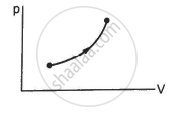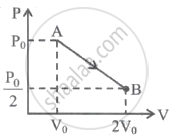Advertisements
Advertisements
प्रश्न
A uniform tube closed at one end, contains a pellet of mercury 10 cm long. When the tube is kept vertically with the closed-end upward, the length of the air column trapped is 20 cm. Find the length of the air column trapped when the tube is inverted so that the closed-end goes down. Atmospheric pressure = 75 cm of mercury.
उत्तर
Let the CSA of the tube be A .
Initial volume of air , V1 = 20A cm = 0.2A
Length of mercury , h = 0.1 m
Let the pressure of the trapped air when the tube is inverted and vertical be P1.
Now , Pressure of the mercury and trapped air balances the atmospheric pressure . Thus ,
P1 + `0.1rho g` = `0.75rho g`
⇒ P1 = `0.65rho g`
when the tube is inverted with the closed end down , the pressure acting upon the trapped air is
Atmospheric pressure + Mercury column pressure
Now ,
Pressure of trapped air = Atmospheric Pressure + Mercury column Pressure [In equilibrium]
P2 = `0.75 rho g` + `0.1rho g` = `0.85 rho g`
Applying the Boyle's law when the temperature remains constant , we get
P1 V1 = P2V2
Let the new height of the trapped air be x .
⇒ `0.65 rho g`0.2A = `0.85rho g`xA
⇒ x = 0.15 m = 15 cm
APPEARS IN
संबंधित प्रश्न
An air bubble of volume 1.0 cm3 rises from the bottom of a lake 40 m deep at a temperature of 12 °C. To what volume does it grow when it reaches the surface, which is at a temperature of 35 °C?
Consider a collision between an oxygen molecule and a hydrogen molecule in a mixture of oxygen and hydrogen kept at room temperature. Which of the following are possible?
(a) The kinetic energies of both the molecules increase.
(b) The kinetic energies of both the molecules decrease.
(c) kinetic energy of the oxygen molecule increases and that of the hydrogen molecule decreases.
(d) The kinetic energy of the hydrogen molecule increases and that of the oxygen molecule decreases.
Consider a mixture of oxygen and hydrogen kept at room temperature. As compared to a hydrogen molecule an oxygen molecule hits the wall
Calculate the mass of 1 cm3 of oxygen kept at STP.
An electric bulb of volume 250 cc was sealed during manufacturing at a pressure of 10−3 mm of mercury at 27°C. Compute the number of air molecules contained in the bulb. Avogadro constant = 6 × 1023 mol−1, density of mercury = 13600 kg m−3 and g = 10 m s−2.
Use R=8.314J K-1 mol-1
The density of an ideal gas is 1.25 × 10−3 g cm−3 at STP. Calculate the molecular weight of the gas.
Use R=8.31J K-1 mol-1
A vertical cylinder of height 100 cm contains air at a constant temperature. The top is closed by a frictionless light piston. The atmospheric pressure is equal to 75 cm of mercury. Mercury is slowly poured over the piston. Find the maximum height of the mercury column that can be put on the piston.
The ratio Cp / Cv for a gas is 1.29. What is the degree of freedom of the molecules of this gas?
Work done by a sample of an ideal gas in a process A is double the work done in another process B. The temperature rises through the same amount in the two processes. If CAand CB be the molar heat capacities for the two processes,
For a solid with a small expansion coefficient,
Let Cv and Cp denote the molar heat capacities of an ideal gas at constant volume and constant pressure respectively. Which of the following is a universal constant?
The figure shows a process on a gas in which pressure and volume both change. The molar heat capacity for this process is C.

The molar heat capacity for the process shown in the figure is

The molar heat capacity of oxygen gas at STP is nearly 2.5 R. As the temperature is increased, it gradually increases and approaches 3.5 R. The most appropriate reason for this behaviour is that at high temperatures
A sample of an ideal gas (γ = 1.5) is compressed adiabatically from a volume of 150 cm3 to 50 cm3. The initial pressure and the initial temperature are 150 kPa and 300 K. Find (a) the number of moles of the gas in the sample (b) the molar heat capacity at constant volume (c) the final pressure and temperature (d) the work done by the gas in the process and (e) the change in internal energy of the gas.
One mole of gas expands obeying the relation as shown in the P-V diagram. The maximum temperature in this process is equal to ______.

